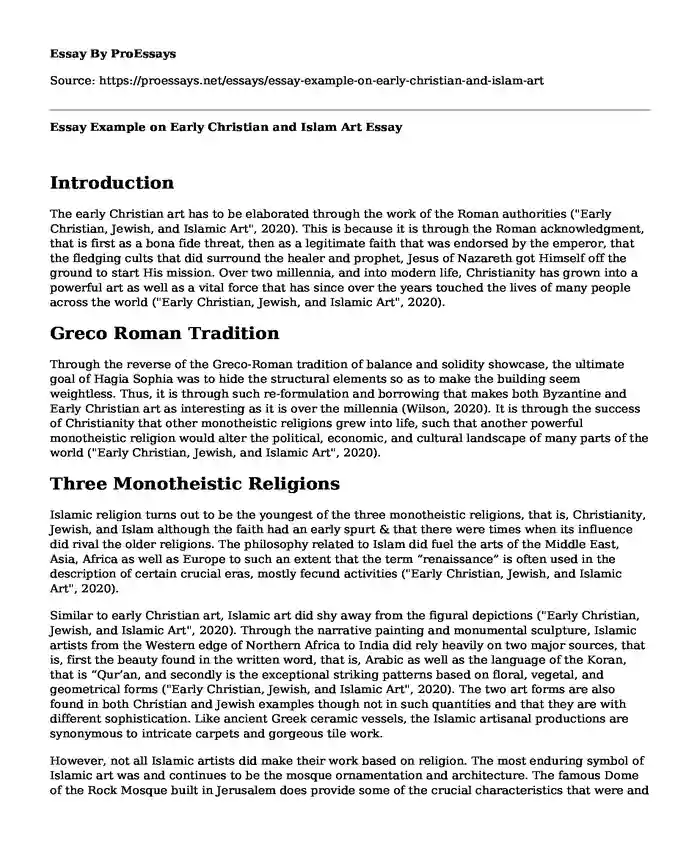Introduction
The early Christian art has to be elaborated through the work of the Roman authorities ("Early Christian, Jewish, and Islamic Art", 2020). This is because it is through the Roman acknowledgment, that is first as a bona fide threat, then as a legitimate faith that was endorsed by the emperor, that the fledging cults that did surround the healer and prophet, Jesus of Nazareth got Himself off the ground to start His mission. Over two millennia, and into modern life, Christianity has grown into a powerful art as well as a vital force that has since over the years touched the lives of many people across the world ("Early Christian, Jewish, and Islamic Art", 2020).
Greco Roman Tradition
Through the reverse of the Greco-Roman tradition of balance and solidity showcase, the ultimate goal of Hagia Sophia was to hide the structural elements so as to make the building seem weightless. Thus, it is through such re-formulation and borrowing that makes both Byzantine and Early Christian art as interesting as it is over the millennia (Wilson, 2020). It is through the success of Christianity that other monotheistic religions grew into life, such that another powerful monotheistic religion would alter the political, economic, and cultural landscape of many parts of the world ("Early Christian, Jewish, and Islamic Art", 2020).
Three Monotheistic Religions
Islamic religion turns out to be the youngest of the three monotheistic religions, that is, Christianity, Jewish, and Islam although the faith had an early spurt & that there were times when its influence did rival the older religions. The philosophy related to Islam did fuel the arts of the Middle East, Asia, Africa as well as Europe to such an extent that the term “renaissance” is often used in the description of certain crucial eras, mostly fecund activities ("Early Christian, Jewish, and Islamic Art", 2020).
Similar to early Christian art, Islamic art did shy away from the figural depictions ("Early Christian, Jewish, and Islamic Art", 2020). Through the narrative painting and monumental sculpture, Islamic artists from the Western edge of Northern Africa to India did rely heavily on two major sources, that is, first the beauty found in the written word, that is, Arabic as well as the language of the Koran, that is “Qur’an, and secondly is the exceptional striking patterns based on floral, vegetal, and geometrical forms ("Early Christian, Jewish, and Islamic Art", 2020). The two art forms are also found in both Christian and Jewish examples though not in such quantities and that they are with different sophistication. Like ancient Greek ceramic vessels, the Islamic artisanal productions are synonymous to intricate carpets and gorgeous tile work.
However, not all Islamic artists did make their work based on religion. The most enduring symbol of Islamic art was and continues to be the mosque ornamentation and architecture. The famous Dome of the Rock Mosque built in Jerusalem does provide some of the crucial characteristics that were and continue to be repeated in other mosques. The mosque stands out to be the oldest surviving piece of Islamic art and architecture in the world located on top of most sacred Jewish sites & across a small valley from the world’s holiest Christian site. The spiritual authority of the mosque emerges from its location on Mount Moriah, and this is where Abraham’s or rather, Ibrahim’s faith was tested about two millennia before; this is also where Prophet Muhammad was taken on a spiritual journey. Also, this is the same site hosting the first two Jewish temples ("Early Christian, Jewish, and Islamic Art", 2020).
Conclusion
Thus, for these reasons and facts, the site is therefore regarded as the holiest place, in which one could not ask for a better spiritual location for a temple than this one. The Dome of the Rock did set a standard through its radially symmetrical floor plan, philosophically antithetical to the long axial Basilica floor plan. This is closer in spirit to the central plan church except that it is near octagonal. Due to the fact that text played a central role in the Islamic faith, the Islamic communities were said to be literate in comparison with their Christian counterparts ("Early Christian, Jewish, and Islamic Art", 2020).
References
Early Christian, Byzantine, and Islamic Art Review. (2020). Presentation.
Early Christian, Jewish, and Islamic Art. (2020). Lecture.
Jewish and Early Christian Art. Art History Teaching Resources. (2020). Retrieved 4 October 2020, from http://arthistoryteachingresources.org/lessons/jewish-and-early-christian-art/.
Wilson, T. (2020). Jewish, Early Christian, Byzantine and Islamic Art | Bartleby. Bartleby.com. Retrieved 4 October 2020, from
https://www.bartleby.com/essay/Jewish-Early-Christian-Byzantine-and-Islamic-Art-P3S2V4LKRZZS.
Cite this page
Essay Example on Early Christian and Islam Art. (2024, Jan 01). Retrieved from https://proessays.net/essays/essay-example-on-early-christian-and-islam-art
If you are the original author of this essay and no longer wish to have it published on the ProEssays website, please click below to request its removal:
- Do Media and Social Media Shape What We Believe - Research Paper Example
- Essay Example on the Great Documents That Shaped the US
- My Critical Reflection of the Media Campaign: 'Holocaust on Your Plate'
- Essay Sample on Hamilton the Musical
- Comparative Film Analysis: Nosferatu and Bride of Frankenstein
- Essay Example on Marketing Music on YouTube: The Ultimate Platform for Musicians
- Free Essay Example on Science vs. Theology: Human Origin & The Supreme Being







